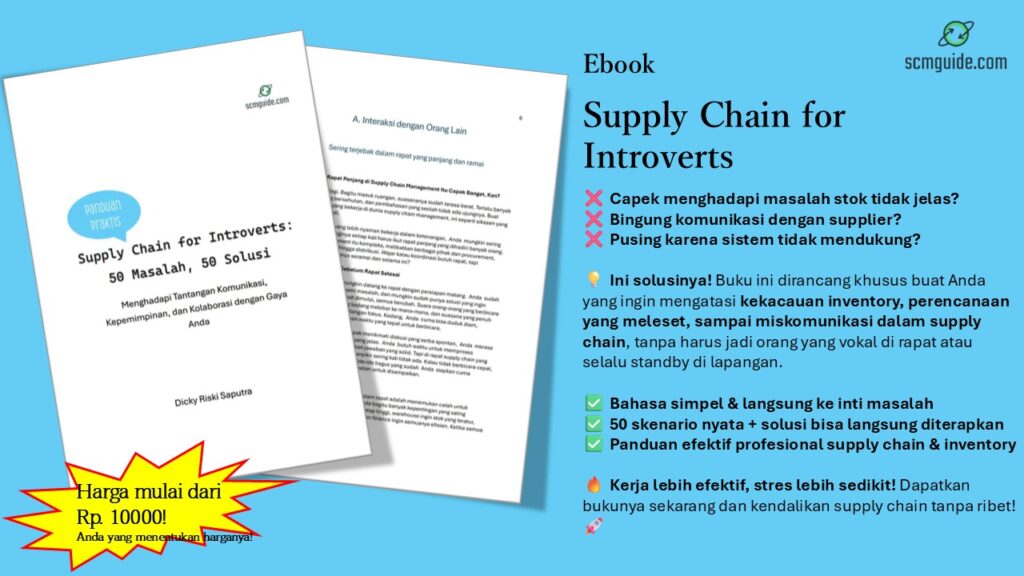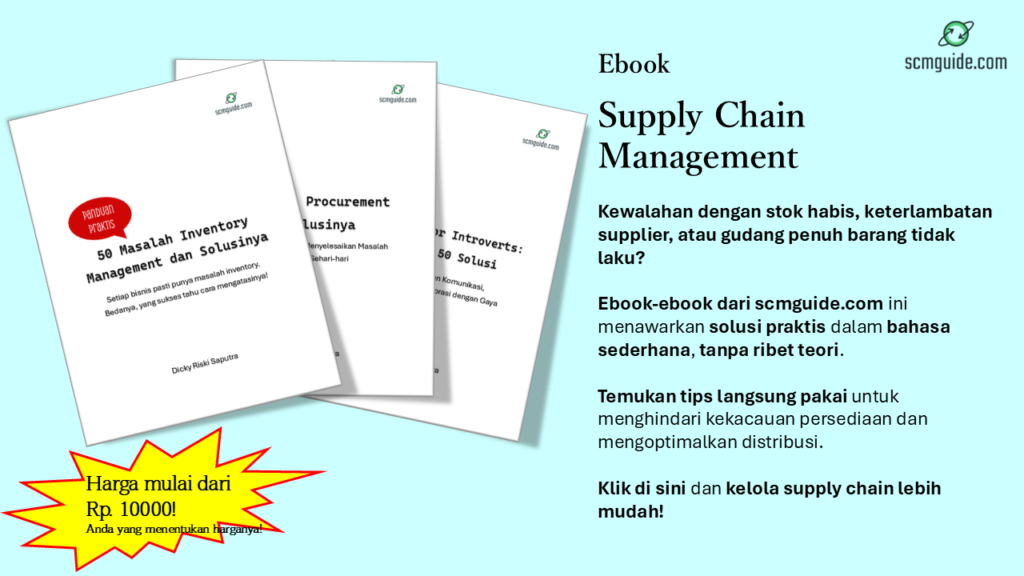Table of Contents
Why Does PPIC Often Become the Target of Complaints?
In a manufacturing company, you might have heard complaints about PPIC (Production Planning and Inventory Control). In fact, in some cases, PPIC is often seen as the “common enemy.” Perhaps you’ve also felt frustrated when the plans set by the PPIC team don’t align with the realities on the ground. Is that really the case? What is it about PPIC that often makes them seem difficult to work with?
Before we go further into this topic, don’t forget to follow my LinkedIn account. You’ll get more helpful insights on supply chain management there.
Getting to Know PPIC: What Is Their Role?
Before diving deeper, it’s important to understand the role of PPIC within a company. In simple terms, PPIC is responsible for ensuring that all production processes run smoothly, from planning to inventory control. They are the ones who determine when and how much product needs to be made and ensure that all raw materials are available when needed.
However, this task is far from easy. Imagine having to coordinate every detail to keep production on track, knowing that even a small delay in one component can throw off the entire schedule. This is the daily challenge faced by the PPIC team.
Between Theory and Reality: Why Do PPIC’s Plans Often Fail to Match Ground Realities?
One reason why PPIC is often seen as the “enemy” is because their plans don’t always align with what’s happening on the ground. For example, PPIC might create a production schedule that looks perfect on paper, but when faced with unexpected machine breakdowns, labor shortages, or sudden changes in customer demand, that plan can quickly fall apart.
From the production team’s perspective, this situation is understandably frustrating. They may feel that PPIC is inflexible and doesn’t understand the real conditions on the shop floor. On the other hand, PPIC faces significant pressure to meet production targets without compromising quality or causing stock overflows. This dilemma is often what leads to tension between PPIC and other departments.
Ineffective Communication: The Root Cause of Many Problems
You’ve probably heard the saying, “communication is key.” In the context of interdepartmental collaboration, this saying couldn’t be more relevant. Often, the issues between PPIC and other departments like production or purchasing don’t stem from incompetence but from a lack of effective communication.
For instance, if there’s an issue on the production line but it isn’t promptly communicated to PPIC, they will continue to operate under the assumption that everything is going according to plan. As a result, when delays or adjustments are needed, PPIC ends up being perceived as unresponsive.
Conversely, if PPIC is too focused on the plan without involving input from the production team, they may make decisions that are unrealistic. Therefore, good, open communication between departments is essential to avoid misunderstandings and to ensure that everyone is working toward the same goals.
You might also like:
- What Repeated Mistakes in Supply Chain Management Can Teach Us
- Why Supply Chain Management is All About People
PPIC and Interdepartmental Conflicts: Why Is There Always Friction?
It’s no secret that PPIC often finds itself at the center of interdepartmental conflicts. Whether it’s with production, purchasing, or even logistics, PPIC has to balance various competing interests. Production wants to keep the machines running, purchasing wants to keep raw material costs down, and logistics wants to ensure timely deliveries. As the gatekeeper of balance, PPIC often has to make decisions that aren’t always popular.
Here, it’s crucial for each department to recognize that PPIC is not the enemy but a partner working toward the same goal: the company’s success. There may be times when you feel that PPIC isn’t supporting your interests, but it’s important to remember that they also have to consider the needs of other departments. By understanding PPIC’s perspective, you can work more effectively together to find solutions that benefit everyone.
Overcoming Negative Stigma: PPIC as a Strategic Partner
To shift the negative perception of PPIC, companies need to change how they view this role. PPIC should no longer be seen merely as a scheduler and inventory manager but as a strategic partner with a vital role in achieving the company’s objectives.
Imagine if PPIC were involved from the beginning in planning major projects. They could provide deep insights into production capacity, supply chain risks, and the best ways to manage inventory. This would lead to decisions that are more realistic and easier to implement on the ground.
For example, in a situation where there’s a sudden change in market demand, PPIC could offer analyses that help the production and purchasing teams adjust their strategies. This highlights that PPIC’s role is not just important but can be instrumental in the overall success of the company’s operations.
Technology: PPIC’s Best Friend in the Modern Era
As technology advances, PPIC’s role has also evolved. With technological support, PPIC now has more sophisticated tools to manage production and inventory. For instance, integrated production management systems allow PPIC to monitor and control the entire process in real-time. This not only makes their job easier but also helps reduce potential errors and increase efficiency.
If you work in another department, understanding and supporting PPIC’s use of technology can greatly improve collaboration. With the right technology, interdepartmental communication can become smoother, and problems that were once difficult to solve can be addressed more quickly and effectively.
Building Stronger Collaboration: Working Together, Not Against Each Other
If you’ve ever felt frustrated working with PPIC, try reconsidering how collaboration can be improved. Instead of seeing them as an obstacle, try viewing PPIC as a partner who can help you achieve greater goals.
One way to strengthen collaboration is by holding regular interdepartmental meetings. In these meetings, each division can share information and discuss the challenges they face. By understanding each other’s constraints and needs, you can find more effective solutions and work more harmoniously.
Additionally, it’s important to always be open to feedback and criticism from PPIC. They may have a different perspective, but this can add value to the decision-making process. By respecting and listening to each other, you can create a more positive and productive work environment.
You might also like:
- Top 10 Common Conflicts Between PPIC and Sales and How to Resolve Them
- The Dual Nature of Automation in Supply Chain Management
Changing Perspectives: From Enemy to Hero
Ultimately, changing perceptions about PPIC requires effort from everyone involved. Instead of continuing to see them as a barrier, try viewing PPIC as the heroes who work hard behind the scenes to keep everything running smoothly.
Remember that without PPIC, production processes could become chaotic, inventory could be either overstocked or understocked, and the company could lose control over its operations. With the right support and collaboration, PPIC can become a force that helps the company grow and achieve success.
Conclusion: Embracing the Crucial Role of PPIC
Through this discussion, I hope you’ve gained a more positive perspective on PPIC’s role. They are not the enemy but a strategic partner crucial in ensuring smooth company operations. With good communication, technological support, and interdepartmental collaboration, the negative stigma often associated with PPIC can be transformed.
So, the next time you hear complaints about PPIC, try to see the situation from their point of view. By doing so, you can more easily find common ground and work together toward shared goals. Let’s start seeing PPIC as unsung heroes who play a major role in the company’s success, rather than as enemies to be avoided.
I hope you find it helpful!
Please share this article with your colleagues so they can also benefit. For more insights on supply chain management, follow my LinkedIn account. You’re free to use all articles on this blog for any purpose, even for commercial use, without needing to give credit.

 by
by 

